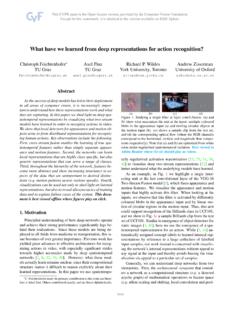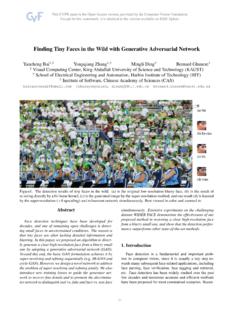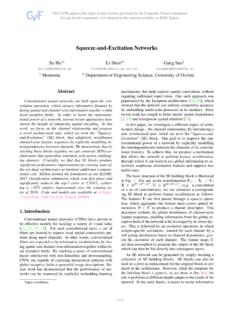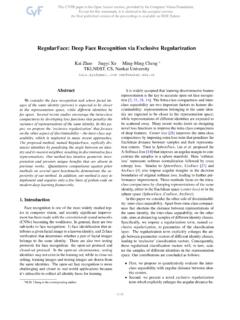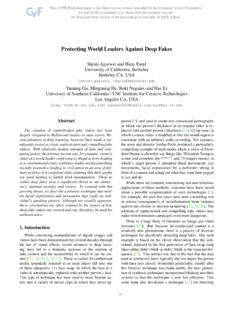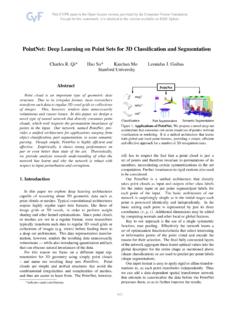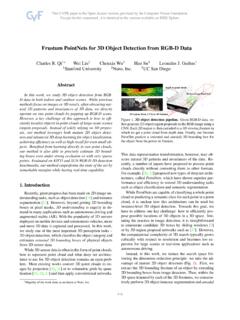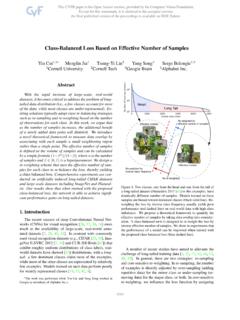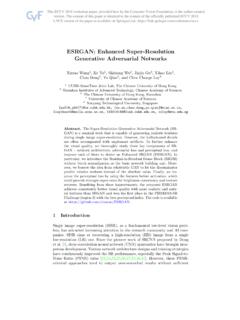Transcription of Auto-DeepLab: Hierarchical Neural Architecture Search for ...
1 Auto-DeepLab: Hierarchical Neural Architecture Search for Semantic Image Segmentation Chenxi Liu1 , Liang-Chieh Chen2 , Florian Schroff2 , Hartwig Adam2 , Wei Hua2 , Alan Yuille1 , Li Fei-Fei3. 1. Johns Hopkins University 2 Google 3 Stanford University Abstract Auto Search Model Cell Network Dataset Days Task Recently, Neural Architecture Search (NAS) has success- ResNet [25] - - Cls fully identified Neural network architectures that exceed hu- DenseNet [31] - - Cls DeepLabv3+ [11] - - Seg man designed ones on large-scale image classification.
2 In NASNet [93] CIFAR-10 2000 Cls this paper, we study NAS for semantic image segmentation. AmoebaNet [62] CIFAR-10 2000 Cls Existing works often focus on searching the repeatable cell PNASNet [47] CIFAR-10 150 Cls structure, while hand-designing the outer network structure DARTS [49] CIFAR-10 4 Cls that controls the spatial resolution changes. This choice DPC [6] Cityscapes 2600 Seg simplifies the Search space, but becomes increasingly prob- Auto-DeepLab Cityscapes 3 Seg lematic for dense image prediction which exhibits a lot more network level architectural variations.
3 Therefore, we pro- Table 1: Comparing our work against other CNN architec- pose to Search the network level structure in addition to the tures with two-level hierarchy. The main differences in- cell level structure, which forms a Hierarchical Architecture clude: (1) we directly Search CNN Architecture for semantic Search space. We present a network level Search space that segmentation, (2) we Search the network level Architecture includes many popular designs, and develop a formulation as well as the cell level one, and (3) our efficient Search only that allows efficient gradient-based Architecture Search (3 requires 3 P100 GPU days.)
4 P100 GPU days on Cityscapes images). We demonstrate the effectiveness of the proposed method on the challeng- ing Cityscapes, PASCAL VOC 2012, and ADE20K datasets. tizing AI, there has been significant interest in designing Auto-DeepLab, our Architecture searched specifically for Neural network architectures automatically, instead of rely- semantic image segmentation, attains state-of-the-art per- ing heavily on expert experience and knowledge. Impor- formance without any ImageNet tantly, in the past year, Neural Architecture Search (NAS).
5 Has successfully identified architectures that exceed human- 1. Introduction designed architectures on large-scale image classification problems [93, 47, 62]. Deep Neural networks have been proved successful Image classification is a good starting point for NAS, across a large variety of artificial intelligence tasks, includ- because it is the most fundamental and well-studied high- ing image recognition [38, 25], speech recognition [27], level recognition task. In addition, there exists benchmark machine translation [73, 81] etc.
6 While better optimiz- datasets ( , CIFAR-10) with relatively small images, re- ers [36] and better normalization techniques [32, 80] cer- sulting in less computation and faster training. However, tainly played an important role, a lot of the progress comes image classification should not be the end point for NAS, from the design of Neural network architectures. In com- and the current success shows promise to extend into more puter vision, this holds true for both image classification demanding domains. In this paper, we study Neural Archi- [38, 72, 75, 76, 74, 25, 85, 31, 30] and dense image predic- tecture Search for semantic image segmentation, an impor- tion [16, 51, 7, 64, 56, 55].
7 Tant computer vision task that assigns a label like person . More recently, in the spirit of AutoML and democra- or bicycle to each pixel in the input image. Work done while an intern at Google. Naively porting ideas from image classification would 1 Codefor Auto-DeepLab released at not suffice for semantic segmentation. In image classifica- tensorflow/models/tree/master/research/d eeplab. tion, NAS typically applies transfer learning from low res- 1 82. olution images to high resolution images [93], whereas op- ADE20K, our best model outperforms several state-of-the- timal architectures for semantic segmentation must inher- art models [90, 44, 82, 88, 83] while using strictly less data ently operate on high resolution imagery.
8 This suggests the for pretraining. need for: (1) a more relaxed and general Search space to To summarize, the contribution of our paper is four-fold: capture the architectural variations brought by the higher Ours is one of the first attempts to extend NAS beyond resolution, and (2) a more efficient Architecture Search tech- image classification to dense image prediction. nique as higher resolution requires heavier computation. We notice that modern CNN designs [25, 85, 31] usu- We propose a network level Architecture Search space ally follow a two-level hierarchy, where the outer network that augments and complements the much-studied cell level controls the spatial resolution changes, and the inner level one, and consider the more challenging joint cell level governs the specific layer-wise computations.
9 The Search of network level and cell level architectures. vast majority of current works on NAS [93, 47, 62, 59, 49] We develop a differentiable, continuous formulation follow this two-level Hierarchical design, but only automat- that conducts the two-level Hierarchical Architecture ically Search the inner cell level while hand-designing the Search efficiently in 3 GPU days. outer network level. This limited Search space becomes problematic for dense image prediction, which is sensitive Without ImageNet pretraining, our model significantly to the spatial resolution changes.
10 Therefore in our work, outperforms FRRN-B and GridNet, and attains com- we propose a trellis-like network level Search space that parable performance with other ImageNet-pretrained augments the commonly-used cell level Search space first state-of-the-art models on Cityscapes. On PASCAL. proposed in [93] to form a Hierarchical Architecture Search VOC 2012 and ADE20K, our best model also outper- space. Our goal is to jointly learn a good combination of forms several state-of-the-art models. repeatable cell structure and network structure specifically for semantic image segmentation.
